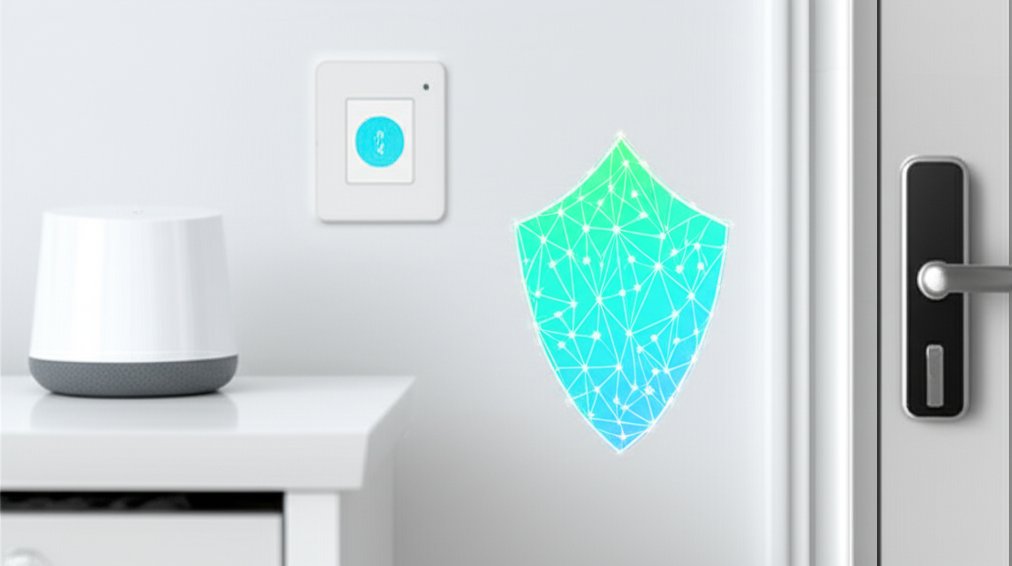7 Practical Ways to Fortify Your Smart Home Network Against IoT Vulnerabilities
Our homes are evolving, aren’t they? From voice assistants orchestrating our favorite playlists to smart thermostats intelligently managing our comfort, the convenience and comfort offered by smart home devices are truly remarkable. Yet, as we embrace this interconnected future, we also introduce new layers of complexity and, critically, new security risks.
The proliferation of smart devices in our homes expands the “attack surface” for cyber threats. IoT vulnerabilities are an increasing concern for everyday users, and it’s understandable if this prospect makes you feel a bit uneasy. The empowering news? Securing your smart home doesn’t demand advanced technical skills. Our objective here is to help you secure your digital sanctuary. We will guide you through 7 practical, non-technical steps you can implement today to strengthen your smart home network against potential threats and safeguard your privacy. For more comprehensive insights into securing home networks, this approach is designed to empower you, not to overwhelm you.
These seven methods have been carefully selected for their significant impact with minimal technical effort, focusing on common vulnerabilities frequently exploited by cybercriminals. They represent foundational security practices that any smart home owner can adopt. Are you ready to learn how to fortify your defenses and ensure your connected life remains safe? Let’s begin.
Why Smart Home Security Matters (More Than You Think)
When we discuss smart home security, we’re not dealing with abstract concepts. We’re addressing tangible risks that can directly impact your personal privacy, financial security, and even physical safety. Consider this: every smart device is essentially a specialized computer connected to the internet, and by extension, to your life.
Common threats range from data breaches exposing personal information (such as your daily routines, habits, or even facial recognition data from smart cameras) to outright device hijacking. We’ve all heard the cautionary tales: baby monitors compromised for unauthorized surveillance, smart cameras broadcasting private moments, or thermostats exploited as entry points into a broader home network. These are not mere sensational headlines; they are real-world risks illustrating how a single compromised smart device can become a gateway for cybercriminals to access your entire network, potentially affecting your computers, phones, and sensitive financial data. To further understand how passwordless authentication can prevent identity theft, this is precisely why we must proactively protect these systems. We wouldn’t leave our front door unlocked, so why would we leave our digital one?
Taking the time to fortify your smart home network isn’t about paranoia; it’s about being prepared and implementing sensible precautions in our increasingly connected world. Let’s delve into how you can achieve just that.
1. Enhance Wi-Fi Router Security to Protect Your Smart Home Network
Your Wi-Fi router is more than just a device that delivers internet; it is the digital guardian of your entire home network. All your smart devices communicate through it, making it the first and most critical line of defense against external threats. Unfortunately, the security of this vital component is often overlooked.
Why it matters: A compromised router can grant attackers access to every device on your network, essentially bypassing all other individual device security measures. By strengthening your router, you establish a robust perimeter defense for your entire smart home ecosystem.
- Change Default Credentials: Manufacturers frequently use generic usernames and passwords (e.g., “admin”/”password”) that are publicly known and easily exploited. Changing these to strong, unique credentials prevents unauthorized access to your router’s settings.
- Enable Strong Encryption (WPA2/WPA3): Ensure your Wi-Fi network uses WPA2 (at minimum) or preferably WPA3. WPA3 is the latest standard, offering superior encryption that scrambles your network traffic, making it incredibly difficult for unauthorized parties to intercept your data.
- Rename Your SSID: Your network’s default name (SSID) often reveals the router’s brand or model, providing hackers with valuable clues. Rename it to something generic and non-identifying to avoid giving away unnecessary information.
- Secure Physical Placement: While less about cyber security, keeping your router in a secure, out-of-reach location prevents unauthorized physical tampering, which could potentially bypass digital defenses.
2. Implement Strong Passwords and Multi-Factor Authentication (MFA) for Smart Device Protection
This advice may be familiar, but its importance cannot be overstated: passwords are your primary defense. If they are weak, predictable, or reused, you are creating an easily exploitable vulnerability across your digital landscape. Every smart device and its associated app requires a strong, unique password. This means complex combinations of uppercase and lowercase letters, numbers, and symbols. A long passphrase is often even more effective, being both easier to remember and significantly harder to crack.
Why it matters: Weak or recycled passwords are the leading cause of account breaches. A single compromised password can give an attacker access to your device, its data, and potentially other accounts if you’ve reused credentials. MFA adds a crucial second barrier, ensuring that even if a password is stolen, your account remains secure.
Managing numerous complex, unique passwords might seem daunting. This is precisely where a reputable password manager becomes indispensable. Tools like LastPass, Bitwarden, or 1Password can securely store, generate, and even auto-fill your credentials, simplifying strong security without compromise. Beyond strong passwords, make it a priority to enable Multi-Factor Authentication (MFA), often referred to as Two-Factor Authentication (2FA), wherever it is offered. This adds an essential layer of security by requiring a second verification method—such as a code sent to your phone, a fingerprint scan, or a physical security key—in addition to your password. Even if a cybercriminal manages to steal your password, they cannot gain access without that second factor. To delve deeper into advanced authentication methods, including whether passwordless authentication is truly secure, most smart device accounts and apps now provide MFA options; activate them immediately.
3. Isolate Smart Devices with a Dedicated IoT Guest Network
Imagine setting aside a separate, securely locked room for your less-trusted gadgets. This is the essence of what a dedicated guest network provides for your smart home devices. This strategy, known as network segmentation, effectively isolates your smart devices from your primary computers, smartphones, and tablets where you store sensitive personal and financial data. Think of it as a digital firewall separating your “toys” from your “treasures.”
Why it matters: This isolation prevents a compromised IoT device from becoming a stepping stone to your more sensitive data. If an inexpensive smart bulb or sensor is breached, the attacker is contained within the guest network, unable to easily pivot to your main network where your banking apps, personal files, and work documents reside. This dramatically limits the potential damage of a breach.
Setting up a guest network is typically straightforward. You can usually find the option in your router’s administration settings (the same interface where you might change your Wi-Fi password). Enable it, assign it a unique name and password, and then connect all your smart home devices to this guest network instead of your main one. It’s a simple configuration change that significantly elevates your overall home network security, providing substantial peace of mind.
Consider this scenario: A smart doorbell camera from a lesser-known brand gets compromised due to a newly discovered vulnerability. If it’s on your main network, an attacker could potentially use it to scan for other vulnerable devices, like your laptop or network-attached storage, and then exploit them to steal personal files or financial data. However, if that doorbell is isolated on a guest network, the breach is contained. The attacker might control the doorbell, but they hit a digital dead end when trying to access your sensitive personal computers, preventing a much larger catastrophe.
4. Keep Smart Devices and Router Firmware Updated for Critical Security Patches
Software and firmware updates might often feel like inconvenient interruptions, but for smart home security, they are absolutely non-negotiable. View them as critical security patches—like reinforcing a castle wall after a weakness has been identified. Device manufacturers are constantly discovering and fixing vulnerabilities in their products’ software; these updates are their mechanism for delivering those vital corrections to you.
Why it matters: Neglecting updates leaves your devices exposed to known exploits that cybercriminals are actively attempting to leverage. Every update closes potential backdoors that hackers could use to gain unauthorized access, steal data, or commandeer your devices. Staying updated is your primary defense against evolving threats.
To maintain continuous security, establish a routine for checking for updates. For most smart devices, this means checking the companion app or the manufacturer’s website. Many modern devices offer automatic updates, which is an ideal feature—enable it whenever possible! Crucially, do not forget your router. Router firmware updates are often a manual process, but they are just as, if not more, critical than device updates. Visit your router manufacturer’s support page, locate your specific model, and download the latest firmware. This relatively quick process can avert significant headaches down the line. Finally, be acutely aware of “end-of-life” devices. If a manufacturer ceases to provide security updates for a product, it becomes a ticking time bomb of unpatched vulnerabilities. It is strongly recommended to replace unsupported devices to mitigate unnecessary risks.
5. Disable Unnecessary Smart Device Features to Reduce Your Attack Surface
When it comes to digital security, a pragmatic rule of thumb is “less is more.” Every feature or service enabled on your smart devices or router that you do not actively use represents a potential entry point for attackers. It’s akin to leaving extra windows open in your home—why provide intruders with more opportunities if they are not needed?
Why it matters: Each active feature or open port can present a vulnerability that an attacker might exploit. By disabling functions you don’t use, you effectively reduce your “attack surface,” closing potential doors that hackers could walk through, making your network inherently more secure.
- Remote Access: While convenient for specific devices, if a smart plug or sensor doesn’t strictly require control from outside your home, disable its remote access feature. If remote access is essential, ensure it is robustly protected by a strong, unique password and Multi-Factor Authentication.
- Universal Plug and Play (UPnP): A significant security risk often found on routers is Universal Plug and Play (UPnP). UPnP allows devices to automatically open ports on your router, simplifying connectivity. However, this convenience comes at a severe cost, as UPnP can be exploited by malware to open ports that cybercriminals can then use to access your network. It is almost universally recommended to disable UPnP in your router settings.
- Other Unused Features: Consider if features like Bluetooth or voice control truly need to be active on every device constantly. If you’re not actively using them, turning them off can further reduce your attack surface. A quick review of your device settings can yield substantial security improvements.
6. Choose Secure Smart Home Devices: Research Before You Invest
The optimal time to consider smart home security is not after you’ve made your purchases; it’s before you commit. Not all smart devices are created equal concerning security and privacy. Just as you would meticulously research a new car, you should similarly investigate your smart gadgets.
Why it matters: Poorly designed or unsecured devices introduce vulnerabilities directly into your home network from day one. Choosing reputable brands with a strong security track record can prevent many common IoT security issues before they even arise, saving you from headaches and potential breaches.
Prioritize purchasing smart devices from reputable brands with a proven track record of prioritizing security. Look for manufacturers known for providing regular software and firmware updates, transparent privacy policies, and responsive customer support for security issues. Actively avoid obscure, no-name brands that may cut corners on security in favor of lower prices. When browsing online or in stores, dedicate a few minutes to reading reviews. Specifically, look for any mentions of security concerns, data breaches, or difficulties with updates. Does the device’s companion app demand excessive permissions? Does the manufacturer offer granular control over your data collection and sharing settings? Be cautious of devices that appear to collect more data than necessary for their core function or that lack clear privacy controls. By performing your due diligence upfront, you can select devices engineered with security in mind, significantly reducing your risk from the moment of installation.
7. Monitor Your Smart Home Network for Suspicious Activity & Consider IoT Security Software
Securing your smart home is not a “set it and forget it” task; it is an ongoing process that demands a degree of vigilance. One of the simplest monitoring steps you can take is to regularly review your router’s list of connected devices. Log into your router’s administrative interface and look for any unfamiliar entries. If you spot a device you don’t recognize, it could be a sign of unauthorized access, and you should investigate it immediately.
Why it matters: Proactive monitoring allows you to detect unauthorized access or suspicious activity early, enabling you to respond before minor incidents escalate into major security breaches. It’s your ongoing check to ensure your defenses are holding strong.
Beyond manual checks, many modern routers are equipped with built-in IoT security features, such as threat detection, vulnerability assessments, or parental controls that can block malicious websites. Explore these options; they can provide an additional layer of automated protection. For even more comprehensive coverage, consider third-party security software or services specifically designed for IoT protection. These solutions can often continuously monitor your network for suspicious activity, alert you to potential vulnerabilities, and even block threats at the network level before they reach your individual devices. Finally, make it a habit to utilize any security features or alerts embedded within your individual smart device apps. Many apps will notify you of unusual activity, failed login attempts, or available updates. By staying informed and adopting these proactive monitoring steps, you are constructing a robust, resilient defense for your entire digital household.
Conclusion
Embracing the smart home lifestyle brings incredible convenience, but it also necessitates taking on the responsibility of protecting your connected life. We have outlined seven essential strategies that, when implemented, can significantly enhance the security posture of your smart home network. From strengthening your router and employing unique passwords to segmenting your network and staying updated, these steps are practical, actionable, and designed for everyday users like you.
Remember, you do not need to be a cybersecurity expert to safeguard your smart home. By taking these proactive measures, you are not merely protecting your devices; you are protecting your privacy, your data, and your peace of mind. Do not allow the perceived complexity to deter you. Start small, choose one or two tips to implement today, and gradually expand your security efforts. We strongly encourage you to begin implementing these tips today for lasting peace of mind! For more tips and troubleshooting assistance, consider joining a smart home security community!









